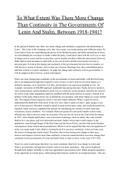To What Extent Was There More Change
Than Continuity in The Governments Of
Lenin And Stalin, Between 1918-1941?
In the period of Stalin's rule, there was much change and continuity compared to the dictatorship of
Lenin. This is due to the changing crisis’ that the country was facing during each different leader, for
Lenin had to focus on consolidating the power of the Bolshevik party, and Stalin instead had to focus
on consolidating his own place as leader within the party. Lenin had to deal with the civil war, so uses
of things such as terror and the secret police can be morally justified within this time period, however,
Stalin had no such resistance to deal with, so any use of terror and the secret police was due to
personal gain. To look at the change and continuity of the governments between the two leaders, we
will discuss a variety of factors, such as their use of terror, ideaology, how they consolidated power
and their control over party machinery. To judge the change and continuity of their governments, it
will be judged on their motives, actions and impacts.
There was more change than continuity in the governments of Lenin and Stalin, with this first being
able to be displayed through their respective uses of terror. Lenin’s motives for terror begun as a
defensive measure, as he faced the Civil War, and needed to use unsavoury methods to win , for
example, executions of 200,000 supposed antibolsheviks during this time. Stalin, however, faced no
such external threat, and the Bolshevik party was in a relatively secure position, therefore his motives
for terror on the wider population cannot be justified with the same motives as Lenin’s. Instead of in
defence of the party, Stalins terror was to defend his own position, with terror taking on a more selfish
role. The impact of their respective terror’s was also widely different. While, it must be not be
understated the death toll of the terror of the civil war, when it came to Lenin’s party purges it was
not a violent process. Members would be asked to hand in their party cards, and would henceforth be
expelled. Stalin, however, amplified this process by introducing the violence of show trials and
executions of party members. For example, Stalin set quotas for each party branch on how many
officials they had to arrest or ready for execution. This can also be seen in the Trial of the Seventeen
in 1937, where Radek and Pyatkov were convicted of sabotage, when in reality, they only critised
Stalin's five year plans, and were henceforth arrested. Stalin’s terror had a wider impact on the
population, seen through Purges of the Red Army and the Secret Police, and also had much bloodier
consequences (mass arrests and assassinations). While it can be argued that that since the appartaus of
terror was made under Lenin, Stalin’s continued use of it can show continuity, it does not take away
the extent of change previously stated. Therefore, due to there being more change in their uses,
motives and impacts of terror more than continuity, it must be stated that there was more change then
continuity in the governments of Lenin and Stalin when it came to terror, in the years 1918-1941.
However, some would argue that there was more continuity than there was change in Lenin and
Stalin’s governments, through their similar control over party machinery. This can be displayed
through both leaders' partiality to who they appointed in government roles. Stalin assigned supporters
of his opponents to remote posts, while putting those that he could rely on in high positions.. This can





